Intel Skylake processors give a lot of bang for the buck.
By Alex Herrera
The big news in the workstation market in the fourth quarter of 2015 was the arrival of Skylake. Workstation vendors had been champing at the bit, waiting on the first release of Intel’s 14-nm processor generation and eager to refresh two key segments of their product offerings: mobile workstations and entry-level desksides. Typically, these two lines get refreshed with at first-launch processor SKUs, leveraging higher levels of integration in quad-core configurations—especially Intel’s Processor Graphics—while waiting until later for more plentiful core SKUs to trigger an update of premium workstations and servers. Market leader HP was at the ready, promptly launching the Z240, the expected follow-on to its high-volume Z230, previously launched in conjunction with Skylake’s predecessor, Haswell.
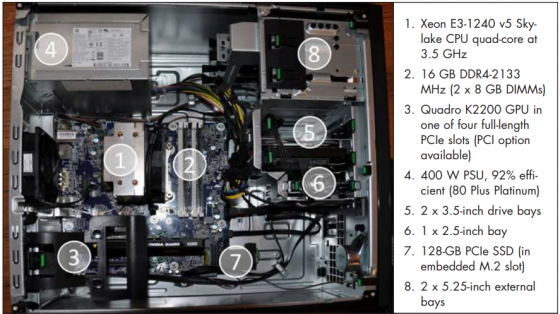
We covered the paper launch of the Z240 back in December, and now we’re ready to check out the real thing. HP sent us a pre-launch unit to review, capably configured with a 3.5-GHz quad-core Xeon E3-1240 v5 (the “v5” indicating Skylake), 16 GB of DDR4 memory, a combination of SSD and HDD dual-drive storage subsystem, and a mid-range Quadro K2200 GPU from Nvidia. Despite sporting a healthy set of premium features, at $2,786, this machine is priced to appeal to the majority of buyers (modestly above the market’s roughly $2,000 ASP for a workstation).
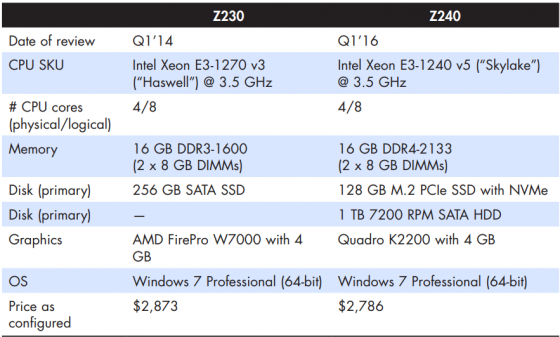
PCI Express, NVMe, and M.2 SSD support come to the entry level
With the Z240, HP touched on a range of design points. Perhaps most significantly, HP has now extended its PCIe SSD offerings to the low end. The PCIe interface, complemented by the recent, higher-performance NVMe software standard, allows bandwidth and latency to substantially exceed what SSDs can manage from the more common hard drive interface, SATA. Where SATA maxes out at 600 MB/second (peak data transfer rate), PCIe Gen2 slots can provide between 1.0 and 2.0 GB/second, depending on whether the slot supports two or four PCIe lanes. Furthermore, the Z240’s PCIe SSD option leverages an M.2 slot, allowing HP to free up a PCIe slot for another add-in.
In addition to the M.2 form factor, this incarnation of PCIe SSDs comes with another critical feature, the NVM Express (NVMe) software interface. Intel’s Advanced Host Controller Interface (AHCI) had been the de facto standard defining how software controls data transfer between system memory and storage devices. However, AHCI was shaped for slower hard disk drive (HDD) technology, and in the age of SSDs has become an unfortunate performance bottleneck. Enter NVMe, replacing AHCI to eliminate those bottlenecks, allowing SSDs to better exploit that higher PCIe bandwidth. How much better? Well, that’s what we were anxious to find out when benchmarking this Z240 (results just ahead).
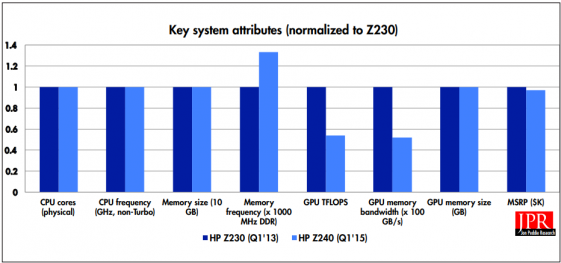
The removable dust filter
Every once in a while, we come across a new feature that seems so obvious and sensible we wonder why it’s taken so long to see it. The introduction of an integrated handle in HP’s inaugural Z line in 2009 was one instance, and now we have another: the removable dust filter, introduced with the Z240. It seems a no-brainer on several levels. It’s inexpensive to implement, yet it makes cleaning the air intake a quick and simple exercise. Most important, making it so easy means it’s much more likely to be done frequently, thereby improving a key workstation attribute: reliability. The only issue we had with the filter was that it was a bit too easy to remove, popping off any time fingers inadvertently pressured the front grill, for example, when moving the machine. Upon reporting this to the folks at HP, we were told the product team had recognized the same issue and designed in a more secure retention system for the released product.
Lots of I/O
The Z240’s rear panel sports both the new and the old in I/O interfaces, while exemplifying how workstations are shaped differently than PCs, and often in seemingly subtle ways. The middle of the panel shows off the new, where three video ports (two DisplayPort and one DVI) reveal the ability of Skylake’s processor graphics (Gen9) to drive three simultaneous high-resolution displays.
It still has old PS/2 ports for keyboard and mouse because many big customers still want them; there are still plenty of old wired PS/2 keyboards and mice floating around.
The OS
For operating system options, it’s worth noting that HP offers both Windows 10 and Windows 7 versions, omitting Windows 8. That all makes sense, since the vast majority of the installed workstation base passed on Windows 8 prior to Windows 10, and now that 10 is here, we can’t imagine many (if any) Z240 buyers would be looking for 8.
Benchmarking the Z240: how much performance does two years buy?
Testing the Z240 was going to be interesting on several fronts. First, how much do generational improvements (i.e., Skylake microarchitecture and modestly faster memory) contribute to raising performance? Second, how much do the not-so-typical improvements like PCIe/NVMe SSD drive up throughput? And last, how much more all-around performance do you get in a workstation now for around $2,800 than you did a couple of years ago?
That last question is perhaps the most salient of all, given that two years has historically represented the typical replacement rate for workstations. As luck would have it, we not only had test results to compare from a similarly priced workstation of two years ago, that machine happened to be none other than the Z240’s predecessor, the Z230, configured to a virtually identical price point.
Charting the two systems’ key attributes, we see that many of the raw hardware metrics have not changed substantially. And in the case of the GPU, the raw capabilities are actually a bit lower (as HP chose a high-end FirePro W7000 back in 2013). However, in this case, the set of raw metrics doesn’t tell the whole performance story, as we found out during testing.
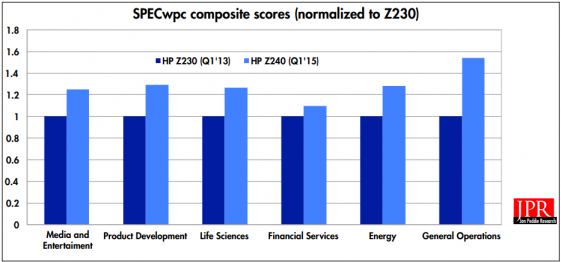
To test and compare workstation performance, we relied as usual on SPEC’s SPECwpc. SPEC calls SPECwpc “the first benchmark to measure all key aspects of workstation performance based on diverse professional applications.” Designed to be comprehensive, the benchmark incorporates six test suites, one per each of six popular workstation verticals: Media and Entertainment, Product Development, Energy, Life Sciences, Financial Services, and General Operations. Each suite includes from five to nine workloads, relevant to those specific spaces. The benchmark reports a composite score, aggregating sub-test results, for each of the six application suites. (It’s worth noting that SPEC has recently released SPECwpc 2.0, but since in this exercise we wanted to compare with a previous system, for which only the first version of the benchmark was available, we stuck with 1.02.)
The results were within our expectations, right off the bat answering that question about how a new, equivalently priced entry workstation can outperform one two years old. The Z240 bested the Z230 consistently and substantially, delivering gains on the benchmark’s six composite scores of between 10% and 54%, with the bulk of gains in the 25% to 30% range.
The results viewed in the context of the raw system metrics raise an obvious question. With the machines’ on-the-surface specs not very different, to what do we owe the big boost in performance? Well, what’s obviously not drawn out in the spec comparison is the relative merits of Skylake versus its predecessor, Haswell. The number of cores is the same, and we’re not using the processor-embedded graphics, so what we’re left with is any microarchitectural improvements in single-thread CPU performance that Skylake might hold over Haswell.
That, unfortunately, is very difficult to peg. But given historical generation-to-generation trends, as well as Intel’s own disclosures, we’re probably looking at 10% to 15% boost, given microarchitectural improvements, averaged across usage and probably slanted to the better case rather than the worse. So, accounting for Skylake, we’re still left with a big gap to explain the healthy 30% gain averaged across SPECwpc workloads. And there’s also the fact that the Z230 had a higher-end GPU to work with, which means there’s more for the Z240 to compensate for in other areas.
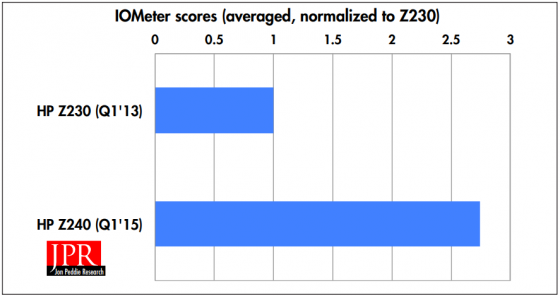
We’ve got modestly faster memory in the Z240, and that, of course, will help generally speaking, but many workloads are not memory bound. Looking at the next level of results, we see some subtests (like Rodinia) that we know won’t be memory bound, and the jump in performance is still in the 25% range. So while faster memory is helping, that’s not where we’re getting 25% either. No, we think we know where the bulk of the Z240’s superiority over the Z230 is, and it’s also clearly shown in sub-tests.
The IOMeter sub-test, weighed in several of the composites, gives the Z240 a whopping 175% advantage over the Z230, by far the biggest edge the Z240 held in any of the many SPECwpc sub-tests. With a lot of experience running SPECwpc (version 1), we know the benchmark is notably sensitive to storage I/O performance. As such, we’ve little doubt that our Z240’s combination of PCIe storage with NVMe support is both delivering that big IOMeter jump and is the biggest (of the several) contributors to the overall 29% improvement in SPECwpc scores. It’s worth emphasizing that the Z230 we used as comparison did not have some old 7200 rpm SATA hard drive, either. It came with a SATA-based SSD, making the improvement in the Z240’s PCIe and NVMe drive features that much more impressive.
What do we think?
Reviewing the Z240 reaffirmed a few points we’ve made in the past about workstations. First, HP makes competitive, well-thought-out products, and in the case of the entry level, that mean it’s very careful on price and adds cost only where it sees solid bang for the buck. Little touches that don’t break BOM budgets, the dust cover, for example, can separate the Z240 from a machine of similar price and build.
Which brings us to our second point. One premium feature HP clearly worked hard to bring to an entry-level price point was PCIe/NVMe SSD. Fast, low-latency access to storage can pay big dividends in performance, as clearly illustrated in the test results. Not only did that storage configuration appear to provide the biggest contribution to performance increases over the two-year-old Z230, it did so while being compared to not a slow hard drive, but a pretty respectable SATA SSD. It illustrates not only the advantage of PCIe, but how much NVMe has effectively removed the performance bottleneck of AHCI.
And finally, point number three. The industry still manages—one way or another—to provide a compelling performance gain over two-year-old products of a similar price. The 29% average boost in SPECwpc is substantial enough to entice most workstation buyers to replace an old machine. And that, in turn, exemplifies the main reason why the workstation market continues to avoid the winds of decline buffeting the broader PC market. Many mainstream PC buyers are finding fewer reasons to upgrade their machines, as two- or three-year-old performance is still acceptable for the bulk of tasks they face.
But not so for professionals in CAD, finance, digital media and entertainment, sciences and research. Those buyers continue to bump into performance bottlenecks in their workflows. And they will continue to invest in products that can deliver a significant incremental gain in performance, in order to drive up their productivity and keep their businesses competitive.
Alex Herrera is a senior analyst at Jon Peddie Research.





